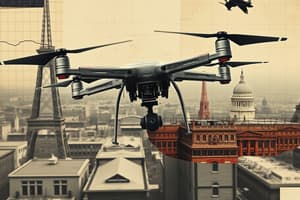Podcast
Questions and Answers
Sectional Charts show airspace in what 2 categories?
Sectional Charts show airspace in what 2 categories?
- Controlled Airspace and Uncontrolled Airspace
- Air Traffic Control and Flight Levels
- Class Airspace and Special Use Airspace (correct)
- Military Airspace and Civilian Airspace
How many classes of airspace are there?
How many classes of airspace are there?
7 - Classes A to G
Class A airspace is generally the airspace from _____ up to and including _____.
Class A airspace is generally the airspace from _____ up to and including _____.
- Surface / FL 600
- FL 180 / FL 600 (correct)
- 8000 feet MSL / FL 600
What does MSL stand for?
What does MSL stand for?
What is the portion of the airspace that has not been designated as Class A, B, C, D, or E?
What is the portion of the airspace that has not been designated as Class A, B, C, D, or E?
Class B airspace is designated for?
Class B airspace is designated for?
Class B airspace is generally airspace from the surface to:
Class B airspace is generally airspace from the surface to:
Operations in Class B, C, D, and E airspace are:
Operations in Class B, C, D, and E airspace are:
What does ATC stand for?
What does ATC stand for?
The airspace directly overlying Fort Worth Meacham airport is:
The airspace directly overlying Fort Worth Meacham airport is:
Class C airspace is designated for?
Class C airspace is designated for?
Class D airspace is designated for?
Class D airspace is designated for?
What is the floor of the Savannah Class C airspace at the shelf area (outer circle)?
What is the floor of the Savannah Class C airspace at the shelf area (outer circle)?
What is a requirement for flying in designated specified airspace?
What is a requirement for flying in designated specified airspace?
According to 14 CFR part 107, the remote pilot-in-command (PIC) of a small unmanned aircraft planning to operate within Class C airspace must:
According to 14 CFR part 107, the remote pilot-in-command (PIC) of a small unmanned aircraft planning to operate within Class C airspace must:
Class C airspace is generally airspace from the surface to:
Class C airspace is generally airspace from the surface to:
According to 14 CFR part 107, how may a remote pilot operate an unmanned aircraft in class C airspace?
According to 14 CFR part 107, how may a remote pilot operate an unmanned aircraft in class C airspace?
You are going to operate inside the B, C, D, or E class airspace. How will you request permission?
You are going to operate inside the B, C, D, or E class airspace. How will you request permission?
Flashcards are hidden until you start studying
Study Notes
Airspace Categories and Regulations
- Sectional charts categorize airspace into Class Airspace and Special Use Airspace.
- There are 7 classes of airspace, labeled A through G.
Class A Airspace
- Extends from FL 180 (18,000 feet) to FL 600 (60,000 feet).
Mean Sea Level (MSL)
- MSL is defined as the altitude above sea level.
Class G (Uncontrolled Airspace)
- The portion of airspace not designated as Class A, B, C, D, or E is classified as Class G Airspace.
Class B Airspace
- Primarily designated for big airports, identified by a solid blue line.
- Extends from the surface up to 10,000 feet MSL.
Air Traffic Control (ATC)
- ATC is Air Traffic Control, required for operations in classes B, C, D, and E airspace.
Class D Airspace
- Designated for small city/town airports, indicated by a dashed blue line.
- The airspace directly above Fort Worth Meacham Airport is classified as Class D Airspace to 3,200 feet MSL.
Class C Airspace
- Marked for regional airports with a solid magenta line.
- Generally extends from the surface to 4,000 feet above airport elevation.
Flying in Specified Airspace
- To operate in designated airspace, ATC or Airport Manager Permission is mandatory.
Remote Pilot Regulations for Class C Airspace
- According to 14 CFR part 107, remote pilots must obtain ATC authorization to operate in Class C airspace.
- Operating in Class C requires prior authorization from the respective ATC facility.
ATC Authorization Process
- To request permission for operations within classes B, C, D, or E airspace, pilots should use the Online Request Form for ATC authorization.
Studying That Suits You
Use AI to generate personalized quizzes and flashcards to suit your learning preferences.




